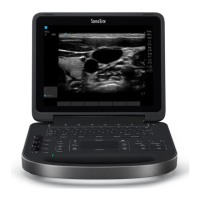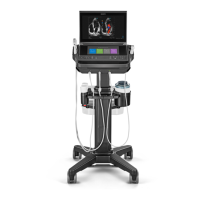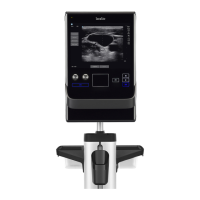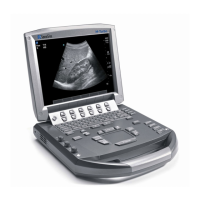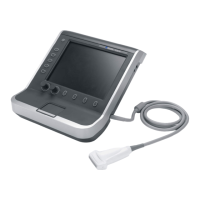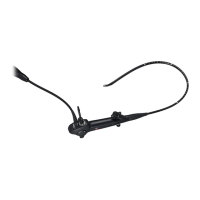Do you have a question about the FujiFilm SonoSite iViz and is the answer not in the manual?
Overview of the SonoSite iViz user guide and its content.
Explains symbols and formatting used throughout the document for clarity.
Provides resources and contact information for technical support and assistance.
Introduces the SonoSite iViz system and its key features for new users.
Details the diagnostic ultrasound applications and intended clinical use of the system.
Specifies conditions or uses for which the SonoSite iViz system is not intended.
Lists and describes compatible accessories and peripherals for the ultrasound system.
Identifies and explains the physical components and ports of the SonoSite iViz system.
Explains the basic operation and user interface of the SonoSite iViz system.
Provides instructions on how to correctly connect a transducer to the ultrasound system.
Guides users through the process of installing the battery and charging the SonoSite iViz.
Details the procedures for powering the SonoSite iViz system on, off, and putting it into sleep mode.
Explains how to adjust system settings related to the Android operating system for optimal use.
Covers system-specific configurations for preferences, printers, and general settings.
Guides users on setting up obstetrics measurements and calculations for specific needs.
Instructions on creating and managing custom labels for different exam types within the system.
Details the process of configuring DICOM profiles for image transfer and network integration.
Explains how to customize parameters for searching patient records efficiently.
Instructions for setting up Electronic Medical Record (EMR) integration and preferences.
Provides guidance on connecting the SonoSite iViz system to an external display device.
Explains the concept of studies and how data is organized for each exam.
Describes methods for opening and navigating the patient information module.
Outlines procedures for locating specific patient records using various search criteria.
Covers viewing, sorting, and sharing patient studies and managing exam data.
Provides steps for entering or modifying patient and exam details within a study.
Instructions on how to properly conclude a patient study session.
Covers editing, printing, and sharing patient exam reports generated by the system.
Offers guidelines for managing system temperature for optimal performance and safety.
Explains the initial steps and methods for starting a new patient exam.
Describes the different imaging modes available on the SonoSite iViz system.
Guides users on selecting the appropriate transducer and exam type for accurate results.
Details how to perform scans and optimize image quality in 2D imaging mode.
Explains how to use and control color Doppler imaging for blood flow visualization.
Covers how to adjust image depth and gain settings for optimal image clarity.
Explains how to use built-in protocols to guide exam procedures and views.
Instructions on how to freeze a real-time ultrasound image for measurements or labeling.
Procedures for capturing and saving still images or video clips during an exam.
How to view and play back saved ultrasound images and clips.
Guidance on annotating images and clips with text labels and arrows.
Steps for removing unwanted images or clips from a study.
Explains methods for exporting and sharing captured ultrasound data.
Overview of performing measurements and saving results within calculations.
Details on using on-screen calipers for accurate measurements of anatomical structures.
Step-by-step instructions for performing common distance, area, and circumference measurements.
Information on performing various calculations and saving them to patient reports.
Guides users on calculating the volume of structures using cuboid or ellipsoid methods.
Explains specific calculations available for different exam types like cardiac and obstetrics.
Information on the precision and accuracy of the system's measurement tools.
Lists references and defines terms used in measurement calculations.
Identifies common problems with the system and provides solutions and troubleshooting steps.
General information regarding system maintenance and care requirements.
Instructions on how to update the system's software and transducer firmware.
Procedures for conducting functional and performance tests on the ultrasound system.
Important preliminary steps and precautions before cleaning or disinfecting the system.
Guidance on selecting the appropriate cleaning level based on contact with bodily fluids.
Detailed procedure for high-level cleaning and disinfection of the system and transducer.
Procedure for low-level cleaning and disinfection when no contact with bodily fluids occurs.
Instructions for cleaning the protective carry case for the ultrasound system.
Guidelines for proper storage of the ultrasound transducer to maintain its condition.
Precautions and procedures for safely transporting the ultrasound transducer.
Information and warnings regarding the proper disposal of the ultrasound system.
Guidelines for comfortable and safe scanning posture to prevent musculoskeletal disorders.
Temperature guidelines for safe operation, storage, charging, and handling of the system.
Information on electrical hazards, precautions, and compliance with safety standards.
Precautions for protecting the ultrasound system, transducer, and accessories.
Warnings and precautions related to the safe handling and use of the system's battery.
Safety considerations during clinical use, including transducer handling and procedure prudence.
Information regarding potentially hazardous materials present in the system and their disposal.
Details on EMC compliance, potential interference, and mitigation measures.
Explanation of the various symbols used on the product, packaging, and containers.
Technical specifications including dimensions, environmental limits, and electrical/battery details.
Lists relevant safety, EMC, acoustic, and wireless standards applicable to the system.
Explains the ALARA principle for minimizing ultrasound exposure during diagnostic imaging.
Categorizes system controls that affect ultrasound output and image quality.
Defines acoustic artifacts and provides examples that can affect image interpretation.
Provides guidance on adjusting parameters to reduce Mechanical and Thermal Indices.
Describes the system's MI and TI output display standards and accuracy.
Presents tables detailing acoustic output for various transducer and operating mode combinations.
Outlines the capabilities of the device when connected to an IT network, such as data storage and worklist querying.
Emphasizes the importance of a secure, isolated IT network for device connectivity.
Details hardware and software specifications for network connectivity and security.
Illustrates the data transfer process between the system, worklist server, and PACS using DICOM.
Describes potential network failures and countermeasures to ensure data integrity and system operation.
Overview of the SonoSite iViz user guide and its content.
Explains symbols and formatting used throughout the document for clarity.
Provides resources and contact information for technical support and assistance.
Introduces the SonoSite iViz system and its key features for new users.
Details the diagnostic ultrasound applications and intended clinical use of the system.
Specifies conditions or uses for which the SonoSite iViz system is not intended.
Lists and describes compatible accessories and peripherals for the ultrasound system.
Identifies and explains the physical components and ports of the SonoSite iViz system.
Explains the basic operation and user interface of the SonoSite iViz system.
Provides instructions on how to correctly connect a transducer to the ultrasound system.
Guides users through the process of installing the battery and charging the SonoSite iViz.
Details the procedures for powering the SonoSite iViz system on, off, and putting it into sleep mode.
Explains how to adjust system settings related to the Android operating system for optimal use.
Covers system-specific configurations for preferences, printers, and general settings.
Guides users on setting up obstetrics measurements and calculations for specific needs.
Instructions on creating and managing custom labels for different exam types within the system.
Details the process of configuring DICOM profiles for image transfer and network integration.
Explains how to customize parameters for searching patient records efficiently.
Instructions for setting up Electronic Medical Record (EMR) integration and preferences.
Provides guidance on connecting the SonoSite iViz system to an external display device.
Explains the concept of studies and how data is organized for each exam.
Describes methods for opening and navigating the patient information module.
Outlines procedures for locating specific patient records using various search criteria.
Covers viewing, sorting, and sharing patient studies and managing exam data.
Provides steps for entering or modifying patient and exam details within a study.
Instructions on how to properly conclude a patient study session.
Covers editing, printing, and sharing patient exam reports generated by the system.
Offers guidelines for managing system temperature for optimal performance and safety.
Explains the initial steps and methods for starting a new patient exam.
Describes the different imaging modes available on the SonoSite iViz system.
Guides users on selecting the appropriate transducer and exam type for accurate results.
Details how to perform scans and optimize image quality in 2D imaging mode.
Explains how to use and control color Doppler imaging for blood flow visualization.
Covers how to adjust image depth and gain settings for optimal image clarity.
Explains how to use built-in protocols to guide exam procedures and views.
Instructions on how to freeze a real-time ultrasound image for measurements or labeling.
Procedures for capturing and saving still images or video clips during an exam.
How to view and play back saved ultrasound images and clips.
Guidance on annotating images and clips with text labels and arrows.
Steps for removing unwanted images or clips from a study.
Explains methods for exporting and sharing captured ultrasound data.
Overview of performing measurements and saving results within calculations.
Details on using on-screen calipers for accurate measurements of anatomical structures.
Step-by-step instructions for performing common distance, area, and circumference measurements.
Information on performing various calculations and saving them to patient reports.
Guides users on calculating the volume of structures using cuboid or ellipsoid methods.
Explains specific calculations available for different exam types like cardiac and obstetrics.
Information on the precision and accuracy of the system's measurement tools.
Lists references and defines terms used in measurement calculations.
Identifies common problems with the system and provides solutions and troubleshooting steps.
General information regarding system maintenance and care requirements.
Instructions on how to update the system's software and transducer firmware.
Procedures for conducting functional and performance tests on the ultrasound system.
Important preliminary steps and precautions before cleaning or disinfecting the system.
Guidance on selecting the appropriate cleaning level based on contact with bodily fluids.
Detailed procedure for high-level cleaning and disinfection of the system and transducer.
Procedure for low-level cleaning and disinfection when no contact with bodily fluids occurs.
Instructions for cleaning the protective carry case for the ultrasound system.
Guidelines for proper storage of the ultrasound transducer to maintain its condition.
Precautions and procedures for safely transporting the ultrasound transducer.
Information and warnings regarding the proper disposal of the ultrasound system.
Guidelines for comfortable and safe scanning posture to prevent musculoskeletal disorders.
Temperature guidelines for safe operation, storage, charging, and handling of the system.
Information on electrical hazards, precautions, and compliance with safety standards.
Precautions for protecting the ultrasound system, transducer, and accessories.
Warnings and precautions related to the safe handling and use of the system's battery.
Safety considerations during clinical use, including transducer handling and procedure prudence.
Information regarding potentially hazardous materials present in the system and their disposal.
Details on EMC compliance, potential interference, and mitigation measures.
Explanation of the various symbols used on the product, packaging, and containers.
Technical specifications including dimensions, environmental limits, and electrical/battery details.
Lists relevant safety, EMC, acoustic, and wireless standards applicable to the system.
Explains the ALARA principle for minimizing ultrasound exposure during diagnostic imaging.
Categorizes system controls that affect ultrasound output and image quality.
Defines acoustic artifacts and provides examples that can affect image interpretation.
Provides guidance on adjusting parameters to reduce Mechanical and Thermal Indices.
Describes the system's MI and TI output display standards and accuracy.
Presents tables detailing acoustic output for various transducer and operating mode combinations.
Outlines the capabilities of the device when connected to an IT network, such as data storage and worklist querying.
Emphasizes the importance of a secure, isolated IT network for device connectivity.
Details hardware and software specifications for network connectivity and security.
Illustrates the data transfer process between the system, worklist server, and PACS using DICOM.
Describes potential network failures and countermeasures to ensure data integrity and system operation.
| Brand | FujiFilm |
|---|---|
| Model | SonoSite iViz |
| Category | Medical Equipment |
| Language | English |
